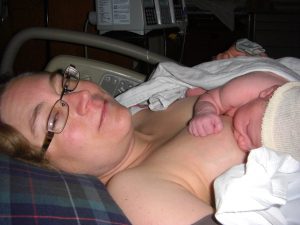Welcome Baby Gribble!
On Sunday, Jess had a horrible stomachache pretty much all day (“It was like a hard knot of pain,” according to Jess). It seemed to have gone away on Monday when she had a routine check-up with the Boulder Nurse-Midwives. At the time we figured it was some of the 24-hour flu that’s been going around, but as it turns out that probably wasn’t the case.
Late Monday night, Jess’s stomach pain returned, and it lasted all night, accompanied by some vomiting. She proclaimed that she would be fine, so Tuesday morning I tried to go into work. By the time I’d arrived, she’d already spoken with the midwives, and they recommended she head into the labor and delivery at Foothills Hospital for a check-up. So, I turned around and headed back to Lafayette to pick up Jess, and we drove back to Boulder together.
After they did some blood work, they determined that she had preeclampsia or HELLP Syndrome (Hemolytic anemia, Elevated Liver enzymes, and Low Platelet count), and that we weren’t going anywhere. It turns out the only real treatment for preeclampsia is the delivery of the baby. So, one way or another, the baby needed to come out.

Jess had been having some contractions for the past week, but she wasn’t really in labor when we arrived. That combined with the need to administer MgSO4 to limit the likelihood of seizures, meant that the dreaded Pitocin (synthetic oxytocin) would also be required. One of the problems with MgSO4 (magnesium sulfate) is that while it reduces the likelihood of seizures (apparently there remains some debate within the literature), it also messes with the function of all of your muscles—the uterus included. That means fewer, weaker contractions. Since that doesn’t lead to having a baby, and having a baby is the only “cure” for preeclampsia, the Pitocin becomes more or less essential.
The midwife also used a Foley bulb to mechanically ripen the cervix. While inserting, and more to the point inflating, the Foley bulb didn’t seem to be at all pleasant, the combination seemed to work pretty well, and the discomfort (read pain) did subside after a few minutes. There are also some alternative cervix ripeners, but this isn’t intended to be a discussion of the many interventions of labor—just the many interventions of Jess’s labor.
Jess and I arrived back at the hospital at around 10:00 in the morning. At that point Jess wasn’t really in labor, but had been having some contractions throughout the previous few days. Due to some nursing shortages that seemed to result from a well-timed spring snowstorm in Boulder, I don’t think the induction actually started until around 7:00 p.m.
They started with the MgSO4 (via IV) along with some IV fluids. As expected, the MgSO4 pretty much stopped what contractions Jess had been having. Angela, our skilled midwife, checked Jess’s cervix and discovered it was only around 1–2 cm dilated but fairly soft. She decided it would be good to try a new Foley bulb that the midwives had started using as a means to mechanically ripen the cervix. Apparently the old bulbs could help dilate to around 4 cm, but the new design was capable of getting the cervix all the way to around 6 cm. Basically they stick the end of a tube just inside the cervix and inflate the tube with saline solution. The bulb is pretty much analogous in design to a hydraulic jack with saline in place of hydraulic fluid (sounds pleasant, huh?). It was clearly a bit painful to insert, but it really did the trick. Between the Foley bulb and the Pitocin, Jess was able to progress all the way from 1 cm to 9 cm dilated in just a few hours. I’m sure it would have taken far longer without the bulb.

By about 11:30, Angela announced that Jess was ready (physically) to begin pushing with contractions. Nevertheless, it still took around another 2 hours to finish off the task. Angela was great at trying to help Jess with her motivation and technique. I don’t know what we would have done without her! Jess did great. She managed to avoid any pain medication, and although she was totally spent by the end of the delivery, she managed to push out a lovely baby girl. Not-so-little Phoebe Anna Gribble (8 pounds and 4 ounces, 19 3/4 inches) officially arrived on March 24, 2010 at 1:37 a.m. MST.
Although Jess is stuck attached to a fancy pump and confined to bed, she’s doing quite well. Luckily Phoebe seems to have no issues from the preeclampsia. All she wants to do is breastfeed, which is a bit tiring for Jess who already is sleep-deprived, but far better than the alternative!
As I’m typing, I’m “enjoying” the “pleasant” rhythms of the labor and delivery room. It’s a little like being someone loaded a John Adams Möbius strip into the rhythm-section equivalent of a player piano. I rather enjoy minimalism—just check out some of my compositions—but after 24 hours of the same dictation, my patience was thinning. Luckily all of the sounds in the maternity side of the building are random!

We look forward to chatting with all of our friends and family over the coming weeks and sharing a ton of cute baby pictures with all of you. For some, this will be payback for all of the photos we’ve been bombarded with. . .err, fortunate enough to receive.